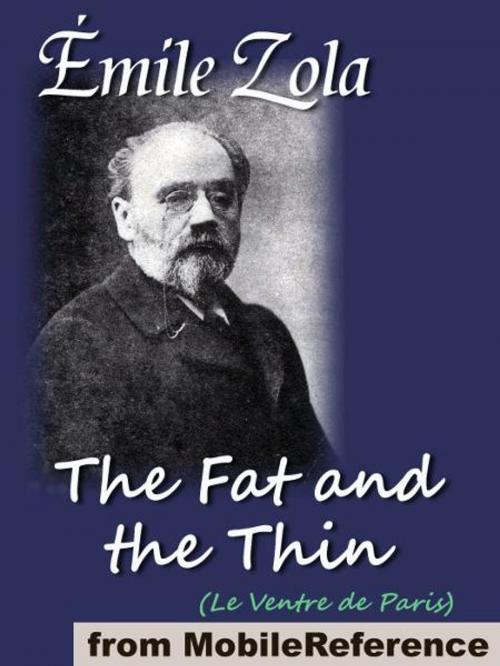The Fat And The Thin: Or The Belly Of Paris (Le Ventre De Paris) (Mobi Classics)
Fiction & Literature, Classics, Historical| Author: | Emile Zola, Ernest Alfred Vizetelly (Translator) | ISBN: | 9781607780601 |
| Publisher: | MobileReference | Publication: | January 1, 2010 |
| Imprint: | MobileReference | Language: | English |
| Author: | Emile Zola, Ernest Alfred Vizetelly (Translator) |
| ISBN: | 9781607780601 |
| Publisher: | MobileReference |
| Publication: | January 1, 2010 |
| Imprint: | MobileReference |
| Language: | English |
Le Ventre de Paris (1873) is the third novel in Emile Zola's twenty-volume series Les Rougon-Macquart. It is set in and around Les Halles, the enormous, busy central marketplace of 19th Century Paris. Le Ventre de Paris (translated into English under many variant titles, but literally meaning The Belly of Paris) is Zola's first novel centred entirely on the working classes.The plot is centred around the escaped political prisoner Florent and the effect he has on Lisa Quenu (formerly Macquart) and her family, with whom he finds refuge. Although Zola had yet to hone his sense for working-class speech and idioms displayed to such good effect in L'Assommoir, the novel still conveys a powerful atmosphere both of life in the great market halls and of working class suffering in general. There are several excellent descriptive passages, the most famous of which, his description of the olfactory sensations experienced upon entering a cheese shop, has become known as the "Cheese Symphony" due to its ingenious orchestral metaphors. Throughout the book, the painter Claude Lantier - himself a relative of the Macquarts and later the central character in Zola's novel L'oeuvre (1886) - shows up to provide a semi-authorial commentary, effectively playing the role of chorus. It is an interesting and often powerful work, though not usually considered as being on a par with the novelist's greater achievements later in the Rougon-Macquart cycle.Le ventre de Paris was originally translated into English by Henry Vizetelly and published in 1888 under the title Fat and Thin. After Vizetelly's imprisonment for obscene libel the novel was one of those revised and expurgated by his son, Ernest Alfred Vizetelly; this mutilated version, entitled The Fat and the Thin, appeared in 1896 and has been reprinted many times since; for most of the period until 2007 this remained the only English version in print. The original full edition was afterwards reprinted in Paris for adventurous English readers. The novel was retranslated for Elek Books in the 1950s under the title Savage Paris, but that translation has long been out of print. However, Oxford World's Classics released a brand-new translation by Brian Nelson in November 2007 Excerpted from Wikipedia, the free encyclopedia.
Le Ventre de Paris (1873) is the third novel in Emile Zola's twenty-volume series Les Rougon-Macquart. It is set in and around Les Halles, the enormous, busy central marketplace of 19th Century Paris. Le Ventre de Paris (translated into English under many variant titles, but literally meaning The Belly of Paris) is Zola's first novel centred entirely on the working classes.The plot is centred around the escaped political prisoner Florent and the effect he has on Lisa Quenu (formerly Macquart) and her family, with whom he finds refuge. Although Zola had yet to hone his sense for working-class speech and idioms displayed to such good effect in L'Assommoir, the novel still conveys a powerful atmosphere both of life in the great market halls and of working class suffering in general. There are several excellent descriptive passages, the most famous of which, his description of the olfactory sensations experienced upon entering a cheese shop, has become known as the "Cheese Symphony" due to its ingenious orchestral metaphors. Throughout the book, the painter Claude Lantier - himself a relative of the Macquarts and later the central character in Zola's novel L'oeuvre (1886) - shows up to provide a semi-authorial commentary, effectively playing the role of chorus. It is an interesting and often powerful work, though not usually considered as being on a par with the novelist's greater achievements later in the Rougon-Macquart cycle.Le ventre de Paris was originally translated into English by Henry Vizetelly and published in 1888 under the title Fat and Thin. After Vizetelly's imprisonment for obscene libel the novel was one of those revised and expurgated by his son, Ernest Alfred Vizetelly; this mutilated version, entitled The Fat and the Thin, appeared in 1896 and has been reprinted many times since; for most of the period until 2007 this remained the only English version in print. The original full edition was afterwards reprinted in Paris for adventurous English readers. The novel was retranslated for Elek Books in the 1950s under the title Savage Paris, but that translation has long been out of print. However, Oxford World's Classics released a brand-new translation by Brian Nelson in November 2007 Excerpted from Wikipedia, the free encyclopedia.















